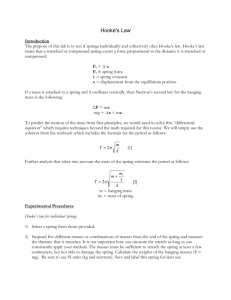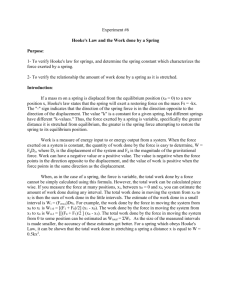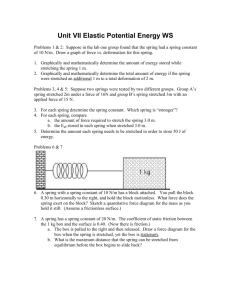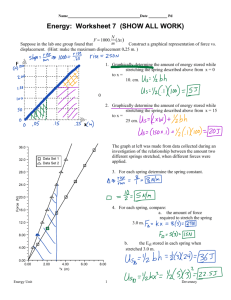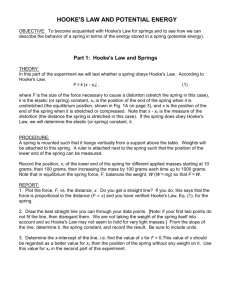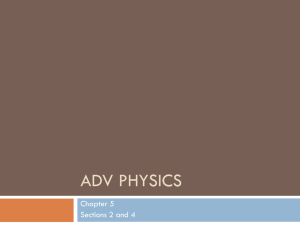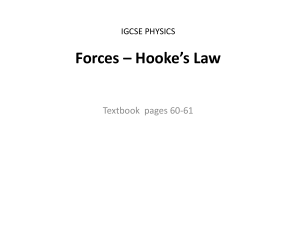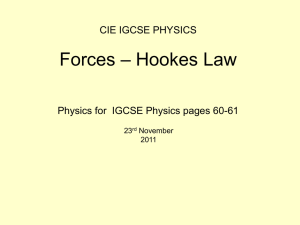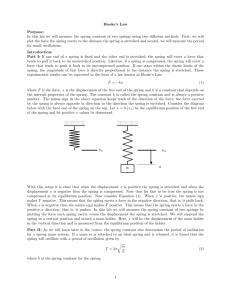Springs and Hooke`s Law
advertisement
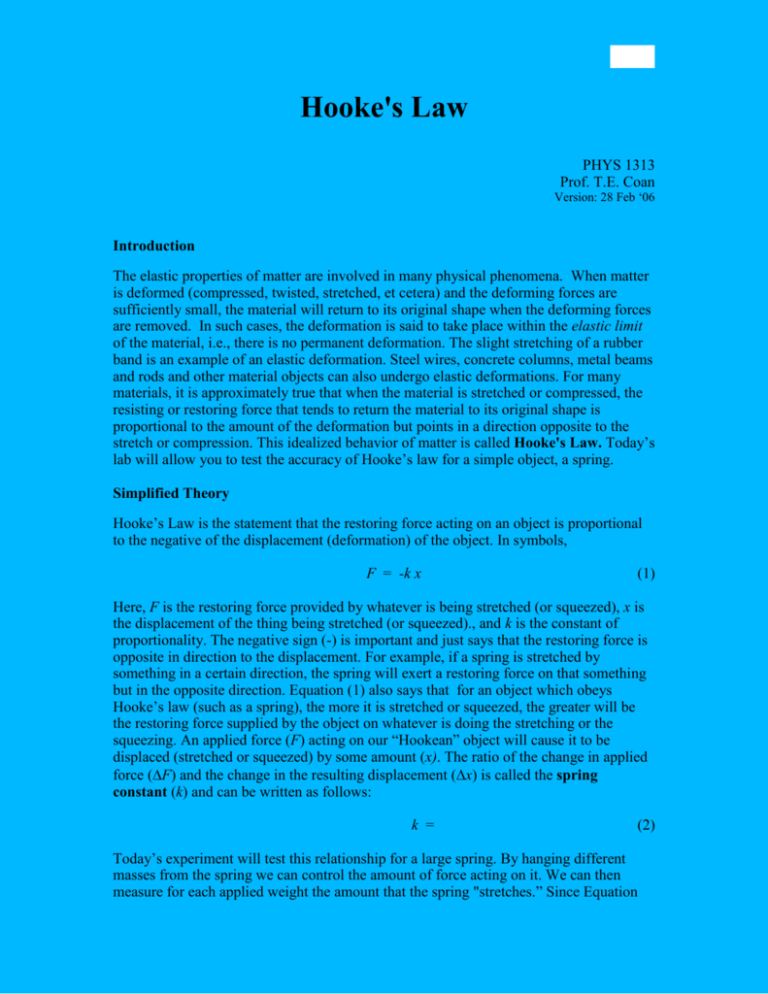
1 Hooke's Law PHYS 1313 Prof. T.E. Coan Version: 28 Feb ‘06 Introduction The elastic properties of matter are involved in many physical phenomena. When matter is deformed (compressed, twisted, stretched, et cetera) and the deforming forces are sufficiently small, the material will return to its original shape when the deforming forces are removed. In such cases, the deformation is said to take place within the elastic limit of the material, i.e., there is no permanent deformation. The slight stretching of a rubber band is an example of an elastic deformation. Steel wires, concrete columns, metal beams and rods and other material objects can also undergo elastic deformations. For many materials, it is approximately true that when the material is stretched or compressed, the resisting or restoring force that tends to return the material to its original shape is proportional to the amount of the deformation but points in a direction opposite to the stretch or compression. This idealized behavior of matter is called Hooke's Law. Today’s lab will allow you to test the accuracy of Hooke’s law for a simple object, a spring. Simplified Theory Hooke’s Law is the statement that the restoring force acting on an object is proportional to the negative of the displacement (deformation) of the object. In symbols, F = -k x (1) Here, F is the restoring force provided by whatever is being stretched (or squeezed), x is the displacement of the thing being stretched (or squeezed)., and k is the constant of proportionality. The negative sign (-) is important and just says that the restoring force is opposite in direction to the displacement. For example, if a spring is stretched by something in a certain direction, the spring will exert a restoring force on that something but in the opposite direction. Equation (1) also says that for an object which obeys Hooke’s law (such as a spring), the more it is stretched or squeezed, the greater will be the restoring force supplied by the object on whatever is doing the stretching or the squeezing. An applied force (F) acting on our “Hookean” object will cause it to be displaced (stretched or squeezed) by some amount (x). The ratio of the change in applied force (F) and the change in the resulting displacement (x) is called the spring constant (k) and can be written as follows: k = (2) Today’s experiment will test this relationship for a large spring. By hanging different masses from the spring we can control the amount of force acting on it. We can then measure for each applied weight the amount that the spring "stretches.” Since Equation 2 (1) is the equation for a straight line, a graph of F (the weight) versus x (the "stretch") will should yield a line with slope k . Equation (2) tells us the same thing and its appearance should remind you of how to compute the slope of a straight line. Procedure 1. Install a table rod with a rod clamp near its top. Suspend a helical spring from the clamp with the large end up. 2. Attach a 50 g weight hook with a 50 g slot mass on it to the spring. Record the initial mass of 100 g as m1. The parameter m will represent the total mass on the spring. 3. Place the meter stick vertically alongside the hanging mass. Measure the elongation of the spring and record it as x1. Always be sure to measure starting at the same place, either on the table or on the clamp. 4. Add a 50 g slot mass to the hook and record m2 (150 g). Read the meter stick and record x2. Repeat, finding x3 , x4 , x5 , and x6 with total masses 200 g, 250 g, 300 g, and 350 g. Record all the masses and elongations on the form provided. Analysis 1. Convert all masses to Newtons and all meter stick readings to meters. 2. Plot all the data on the graph paper. F will be plotted in the vertical direction, while x will be plotted in the horizontal direction. Label the axes of your graph and include units. 3. Take a straight edge and draw a single "best fit" line through all the data points. 4. Measure the "rise over run" (the slope) of this line. This is your experimental value for the spring constant. In what units should k be reported? Conclusions 1. Write down you general conclusions for this experiment. These conclusions should include the value of the spring constant k and an estimate of its error. 2. Did your plotted data form a straight line? Does the data from another shape, perhaps a parabola? 3. If your graph was not a straight line, what does this tell you about the spring? 3 k k 4. Consider a set of two identical springs each of spring constant k connected in parallel (side by side) to a single mass. What would you expect the total spring constant to be of the system? Why? (Hint: think about the spring force as a vector.) M Error Analysis Look at how much the points scatter around your "best fit" line. The more they scatter, the poorer the precision. Does the graph form some other shape besides a straight line, such as a parabola? (This could mean that Hooke's Law is not valid for this spring.) What is your estimate of the error in k and how did you estimate this error? What are the sources of error for your data points and what is the relevance of these errors in your determination of k? 4 Hooke's Law PHYS 1313 Prof. T.E. Coan Version: 29 Jul ‘99 Name _________________________________Section _________ Abstract: Data n 1 2 3 4 5 6 x Graph Separately. k = Conclusions Error Analysis: M F = mg 5
